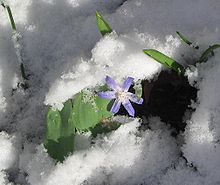- Chionodoxa
-
Chionodoxa Glory-of-the-snow in the snow Scientific classification 
Kingdom: Plantae clade: Angiosperms clade: Monocots Order: Asparagales Family: Asparagaceae Subfamily: Scilloideae Genus: Chionodoxa
Boiss.Species See text.
Chionodoxa (Glory-of-the-snow) is a small genus of bulbous perennials in the family Asparagaceae, subfamily Scilloideae.[1] The genus is endemic to the eastern Mediterranean region, specifically Crete, Cyprus and Turkey. The blue, white or pink flowers appear early in the year making them valuable garden ornamentals. The common name of the genus is based on the habit of flowering in high alpine zones when the snow melts in spring.[2]
Contents
Taxonomy
Chionodoxa is distinguished from the closely related genus Scilla by two features: the tepals are joined at their bases to form a tube rather than being free; and the stamens have flattened stalks (filaments), which look almost like a cup in the centre of the flower.[3] These differences are not considered by some botanists as sufficient to create a separate genus, and Chionodoxa species are often included in Scilla.[4]
The taxonomy of the genus is confused. Several of the species are very similar, and the number of species recognized as distinct varies significantly from one source to another. For example, plants occurring in Crete have at one time or another been put into three species: C. albescens, C. cretica and C. nana. Sfikas' Wild flowers of Crete recognizes only two of these (C. cretica and C. nana);[5] the Natural History Museum's checklist of the Cretan Flora recognizes only one (C. nana, as Scilla nana).[6] The Royal Horticultural Society distinguishes between C. forbesii and C. siehei; other botanists recognize only C. forbesii.[4]
Assuming there are six species, as listed below, three occur in west Turkey, one in south-west Turkey, one in Crete and one in Cyprus.[2] Garden plants have naturalised outside of their native range, e.g. in the UK, Germany, Austria and the Netherlands. A natural hybrid C. siehei x C. luciliae also occurs.
Garden use
 Self-sown carpet of Chionodoxa siehei under a deciduous shrub, flowering in early April in the West Midlands, England.
Self-sown carpet of Chionodoxa siehei under a deciduous shrub, flowering in early April in the West Midlands, England.
There has been considerable confusion over the correct names of species grown in gardens, with the commonest being called either C. luciliae, C. forbesii or C. siehei. A 2005 Royal Horticultural Society publication which illustrates all three of these species states that the commonest garden species is properly called C. siehei.[4]
Three species were awarded the RHS Award of Garden Merit (H4 – hardy outdoors anywhere in the British Isles) in 1993 which was re-confirmed in 2004: C. luciliae, C. sardensis and C. siehei. (C. nana subsp. albescens was also given the award subject to availability.)
All can be bought as dry bulbs and planted while dormant in late summer or early autumn at a depth of 8-10 cm. They require light when in growth, but can be grown under deciduous trees or shrubs, as their foliage dies down after flowering. All flower in early Spring, C. sardensis usually being the earliest. C. siehei seeds freely in many gardens, and can create a carpet of blue.[7]
Species
- Chionodoxa albescens (Pale Glory-of-the-snow) - Crete – see C. nana
- Chionodoxa cretica (Cretan Glory-of-the-snow) - Crete – see C. nana
- Chionodoxa forbesii (Forbes' Glory-of-the-snow) - south-west Turkey
- Chionodoxa lochiae, synonym C. gigantea (Loch's Glory-of-the-snow) - Cyprus
- Chionodoxa luciliae (Lucile's Glory-of-the-snow) - west Turkey
- Chionodoxa nana (Dwarf Glory-of-the-snow) - Crete
- Chionodoxa sardensis (Lesser Glory-of-the-snow) - west Turkey
- Chionodoxa siehei, synonyms C. tmoli, C. tmolusii (Siehe's Glory-of-the-snow) - west Turkey; the commonest garden form
Notes and references
- ^ Stevens, P.F. (2001 onwards), Angiosperm Phylogeny Website: Asparagales: Scilloideae, http://www.mobot.org/mobot/research/apweb/orders/asparagalesweb.htm#Hyacinthaceae
- ^ a b Beckett & Grey-Wilson 1993, pp. 284–5
- ^ Mathew 1987, pp. 25
- ^ a b c Dashwood & Mathew 2005, p. 5
- ^ Sfikas 1987, p. 268
- ^ Turland et al. 1993, p. 185
- ^ Dashwood & Mathew 2005
Bibliography
- Beckett, Kenneth; Grey-Wilson, Christopher, eds. (1993), Alpine Garden Society Encyclopaedia of Alpines, Vol. 1 (A-K), Pershore, UK: AGS Publications, ISBN 978-0-900048-63-0
- Dashwood, Melanie & Mathew, Brian (2005), Hyacinthaceae – little blue bulbs (RHS Plant Trials and Awards, Bulletin Number 11), Royal Horticultural Society, http://www.rhs.org.uk/RHSWebsite/files/04/04d1dd16-01be-4c31-9510-8a081dfa23b0.pdf, retrieved 3 April 2010
- Mathew, Brian (1987), The Smaller Bulbs, London: B T Batsford, ISBN 978-0-7134-4922-8
- Mathew, Brian (2005), "Hardy Hyacinthaceae, Part 2: Scilla, Chionodoxa, xChionoscilla", The Plantsman (New Series) 4 (2): 110–21
- Sfikas, George (1987), Wild Flowers of Crete, Athens: Efstathiadis, ISBN 978-960-226-052-4
- Turland, N.J.; Chilton, L.; Press, J.R & Natural History Museum (London) (1993), Flora of the Cretan Area: annotated checklist and atlas, London: HMSO, ISBN 978-0-11-310043-9
Categories:- Asparagaceae genera
- Scilloideae
Wikimedia Foundation. 2010.


